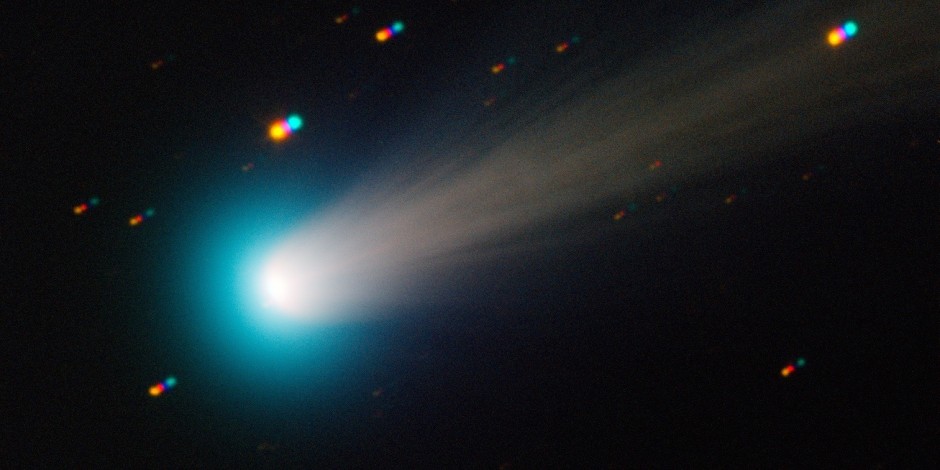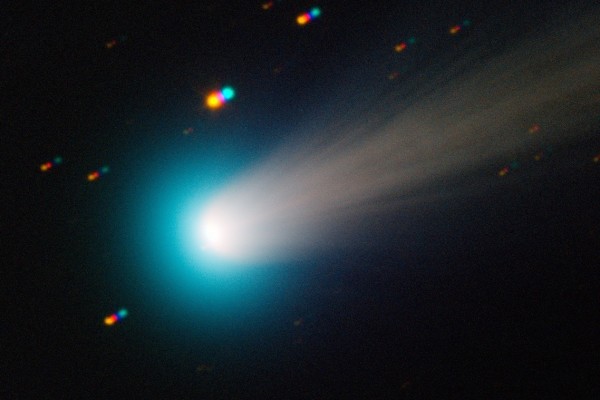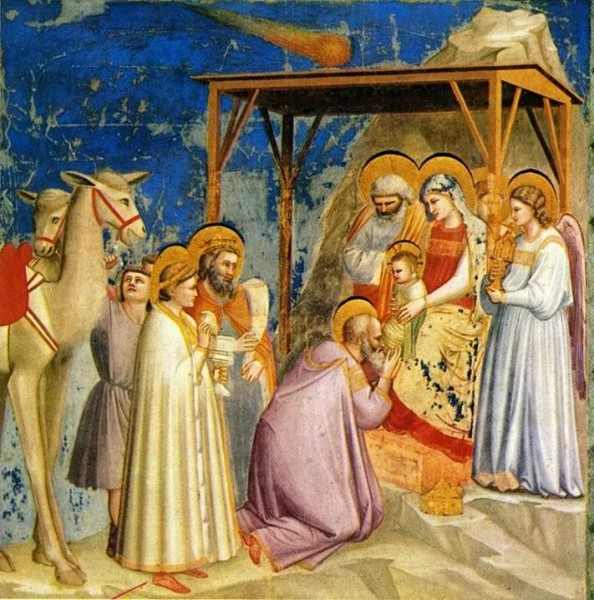The Bethlehem Star

Did planets guide the Three Wise Men to the stable near Bethlehem two millennia ago? Or a comet? Or is the famous star mere literary fiction as in the Hellenistic and Roman world, depictions of kings and emperors were usually accompanied by a star?

Comet C/2012 S1 (ISON) photographed at ESO’s La Silla Observatory on 15 November 2013 with the TRAPPIST national telescope (TRAnsiting Planets and PlanetesImals Small Telescope). (Image: ESO)
By Carsten Knigge
For generations children and grown-ups alike have been delighted by the story of the birth of Jesus as recorded in the Gospel of St. Luke in the New Testament. Surely no other text in the Christian-influenced world is better known and more closely associated with Christmas than the narrative, thousands of years old, about Mary and Joseph, whose son Jesus had to be born in a barn near Bethlehem because there was no room in the inn; the narrative about the nearby shepherds, stunned by the heavenly light and the angels’ singing. In the collective memory of Christianity, this version has coalesced with the second biblical version of the story, St. Matthew’s, to create a narrative unity. It’s from Matthew that we learn about the Three Wise Men from the Orient, who, guided by a distinct celestial phenomenon, had set off to pay homage to the new-born child. For the sake of completeness it’s worth pointing out that it’s only in the extra-biblical tradition of subsequent centuries that the Wise Men were promoted to “kings” and the ox and ass added to the personnel of the stable.
We won’t go into the issue of the exact date of Jesus’s birth here. Suffice to say, assuming that the two stories of the divine birth are reports of a real incident, the accounts could be said to originate from about 80 to 100 years after the occurrence reported. It was only another 100 or so years after that than theological scholars in the early Christian church (e.g., Origen, ca. 230) started searching for explanations as to what celestial phenomenon could have been described by St. Matthew in his gospel. Beginning in Late Antiquity (5th century), the theory gained currency that the Wise Men had seen a comet. This assumption survived for centuries. It possibly originated in what Hellenistic philosophers and early Christian theologians knew about the ancient Babylonians. Centuries before Christ, their astronomer-astrologists had already been able to compute the courses of stars and comets. From the point of view of Jerusalem and Bethlehem, Babylon was the Orient!
Suspecting Halley’s Comet
During the late Middle Ages (13th/14th centuries) the comet theory became more concrete, as Halley’s Comet had been (re-)discovered and observed. This was brought into connection with a number of records from Antiquity and the Far East, and it was considered a pretty safe assumption that the Star of Bethlehem was identical with Halley’s Comet, which had indeed been observable at the time of Jesus’s birth. It was at that time that the first paintings emerged (e.g., Giotto, 1302) depicting a star with a comet’s tail located above the stable in Bethlehem – iconography that has retained its fascination until the present day. This is all the more astonishing given that in almost all cultures, nocturnal comet occurrences have more or less always been viewed with suspicion as omens of accidents and disasters. So it doesn’t seem to make sense that a comet would be seen as a sign of Christ’s birth and God’s incarnation.
Perhaps with the purpose of resolving this contradiction, after the Middle Ages scientists rather than theologians started seeking alternative models for explaining the Star of Bethlehem. In subsequent centuries, right up to the present, it has been the German astronomer Johannes Kepler who has been behind attempts to formulate hypotheses. On the basis of his own observations of the heavens in the years 1604 and 1605 he proposed a triple conjunction of the planets Mars, Jupiter, and Saturn, followed by a supernova, which might have been visible in the Near and Middle East at the point of the birth of Jesus. In 1604 the supernova did indeed coincide with the triple conjunction. But naturally the causal link assumed by Kepler and his contemporaries was false. So while the triple conjunction in antiquity remains undisputed to this today, there is no evidence for any supernova observable in the Middle East at that time.
In recent times there has been debate as to whether a conjunction of the planets Venus and Jupiter, computed for the years 3 and 2 BC, might have been the reality behind the Star of Bethlehem. An even simpler assertion has also been discussed: that the Wise Men might have considered Venus, at her heliacal rising, to be a meaningful sign. This celestial phenomenon might therefore be linked to the Biblical reference to the Messiah as the “Morning Star.” In recent times the supernova hypothesis has again been seized upon by some biblical scholars, although they lack any astronomical evidence of such an occurrence visible in the Orient around the time of Christ’s birth.
Ultimately none of the astronomy-based hypotheses is fully accepted by scholars, since they are all too speculative, or there are too many uncertainties and objections militating against them. Not only that, but the calculated dates of occurrences and observations seem to contradict each other far too seriously for them to be associated with a single celestial phenomenon that was both observable in reality and reported in the Bible.
The star as an attribute of royal power
This evidence leads us towards a second complex of hypotheses and theories running under the banner of literary exegesis. Since the early 20th century, theologians and biblical scholars have considered the Gospel narratives not primarily as factual reports, but as a series of mythological and symbolic characters and lines of action. So it would be vain and useless to seek an astronomical counterpart to the Star of Bethlehem, since it would be nothing real, but theological or literary fiction. In fact, in the Ancient East the birth or arrival of kings was associated or even equated with bright celestial phenomena and the rising of certain stars or astral constellations. In Israel, at the time the Hebrew Old Testament emerged, the arrival of the eagerly awaited Messiah as the “king of Heaven”, or the Messiah himself, was considered to be synonymous with a celestial occurrence or a star. Furthermore, we have Old Testament records of kings paying homage to the anticipated Messiah at his arrival, and making him gifts. According to this hypothesis, the New Testament accounts of the birth of Christ had been written in line with this tradition, or at least in reference to it.
From the historical point of view it is noteworthy that in the Hellenistic and Roman world, depictions of kings and emperors were usually accompanied by a star. Here, the star was considered as an attribute of royal and divinely authorized power. This is attested by dozens of iconic representations on coins of various origins. So it’s not unlikely that the Jewish author of the Biblical birth narrative intended such an association: the Star identifies Jesus as being coequal to both the Roman emperor Augustus and the Judean king Herod. Or more still, it makes him an “anti-king”.
Ultimately, all the ways of explaining the Bethlehem Star are plausible to a certain extent. However, a clear answer as to whether the Star was reality or fiction is still lacking. The Biblical narratives about the birth of Jesus are primarily literary texts. They were therefore written rhetorically and poetically according to the style of the time of their origin. Nowadays it’s simply not possible to judge the extent to which the true core of the story has been modified and complemented in this artificial process. There may be certain celestial phenomena that can be reconstructed as having been observable in the East around the time of Christ’s birth, but the question of whether and what specific occurrence has been put into literary form remains unanswerable.
Categories: External Newsletter


